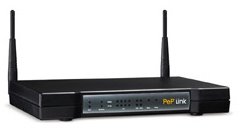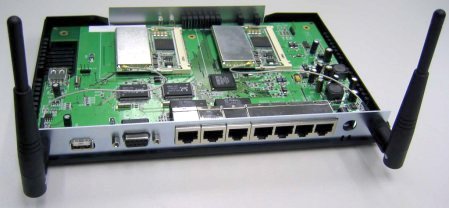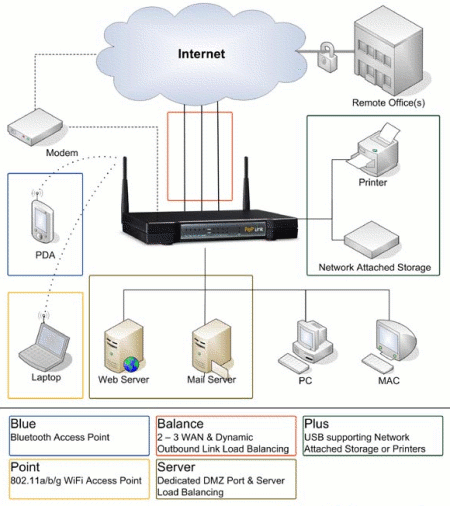Device Profile: Peplink Manga load balancing multi-line access device
Dec 16, 2004 — by LinuxDevices Staff — from the LinuxDevices Archive — 154 viewsThe Peplink Manga (managed adaptive network gateway) is an ARM-based Linux access device platform available in several configurations, including several that support multiple, load-balanced WAN links, including DSL, cable, T1, and modem links. The device targets businesses and service providers.

The Manga can be configured as a wireless access point with dual radios
According to Regional Manager Phillip Stevens, the Manga could be used by cable and DSL providers to “poach” one another's customers. “A cable company [could] get business DSL customers [by saying] 'Keep your DSL, but add this drop-in box and our cable service, for higher reliability.”
Stevens adds, “You'd be unlucky if DSL, cable, T1 and v.90 dial-up all died at the same time.”
The Manga can also be used to support upstream line load balancing (LLB), according to Stevens, who says users hosting their own servers could use the device, along with multiple ADSL lines, in place of more expensive SDSL (synchronous DSL) lines, if the box is configured as its own DNS server.
What's under the hood?
The Manga is based on a Micrel KS-8695P network processor, an SoC (system-on-chip) with a 166MHz ARM9 core, memory management unit (MMU), 5-port managed switch, and 33MHz PCI bridge.

(Click for larger view)
A Manga configured with two wireless radios, one USB port, and one active WAN port
All Manga incarnations include four switched 10/100 Ethernet LAN ports, and at least one WAN port. The physical device includes two additional RJ-45 ports which can be configured as additional WAN ports, at the expense of other PCI-based interfaces. Regional Manager Phillip Stevens explains, “The Micrel [SoC] supports 3x PCI bus masters. We've built the PCB with [a] choice of three from five possibilities at manufacture.”
The five possible PCI devices, of which three can be supported at once, include:
- One VT-6212 USB controller
- Two Realtek Ethernet controllers
- Two mini-PCI slots
All Manga versions provide routing and bridging, a stateful firewall, and an IPsec VPN stack supporting 3DES, AES, NAT, OE, RSA, and X.509 Keys. Beyond that, a number of feature sets are offered, including:
- Plus — Adds NAS (network-attached storage) and print server features based on UHCI USB1.1 and EHCI USB2.0 USB ports
- Balance — Adds one or two additional WAN ports, support for dynamic outbound link load balancing, and dual Flash to support rolling back firmware upgrades remotely
- Server — Assigns one Ethernet port to a DMZ (de-militarized zone) supporting server load balancing
- Point — Adds 802.11a and/or b/g WiFi access point capabilities, based on two onboard mini-PCI slots
- Blue — Adds a Bluetooth radio with MAC-to-WAN, OBEX FTP, and other features

Network diagram showing all Manga device options, some of which are mutually exclusive based on the limitation of three PCI bus masters
Other optional features include:
- DSN-based dynamic inbound link load balancing
- Server load balancing (on any model)
- Mini-PCI IPSec VPN accelerator, providing a claimed 20x speedup
- Plenum certified and rack mount packaging
Peplink lists possible uses for the Manga device as follows:
- Off-network business service termination using GRE, IPSec, or L2TP
- Access network resiliency (load balancing, failover)
- Point-to-multipoint network CPE (customer premises equipment) for 802.1x supplicant devices
- Four-in-one access point providing 802.11a/b/g and long range Bluetooth
- Low cost, solid-state server replacement for monitoring and NAS
Software side
The Manga is based on a 2.4.25 kernel, with USB drivers and modules backported from 2.6.x. Peplink is working on a 2.6.10 kernel, which it will release within a few weeks, according to Stevens.
Almost all the software in the Manga is open source, according to Stevens.The Manga uses busybox 0.60.5, but will move to 1.00 soon. Busybox 1.00 is included with the SDK (software development kit) that Peplink offers for the device. The SDK is the standard GCC ARM cross compilation tool chain for x86, according to Stevens. The firewall software is based on netfilter, with configuration done by Peplink, and the company also developed its link and server load balancing software in-house, Stevens says.
“We've put a lot of effort in our user interface, and tuning the different pieces of code to make a homogenous product.”
Click the links below for screenshots of Manga's user interface:
- Main admin screen
- WAN configuration
- WAN link status
- Load balancing screen
- Load balanced services
- Inbound RealServer
- Inbound load services
Future features
Phillips notes that Peplink is continuing to develop features for the Manga. “We're doing lots of cool things with USB. With VT-6212 USB controllers onboard, we have full USB2.0 support. We've [got] USB camera support working, and can stream video using the Palantir server. We're reverse-engineering a USB-VGA Linux driver, and will probably put a VNC client together with this for your ultimate slim client (it's also your AP and firewall . . .). We're doing a lot with security acceleration hardware, and have developed a good relationship with IdealX, Xelerance, and Hifn. It's our plan to leverage a new (as yet in stealth mode) Open Hardware Security Module project to build an Open Source HSM device (USB smart card reader and USB keypad in a shiny metal box). The list goes on . . .”
This article was originally published on LinuxDevices.com and has been donated to the open source community by QuinStreet Inc. Please visit LinuxToday.com for up-to-date news and articles about Linux and open source.